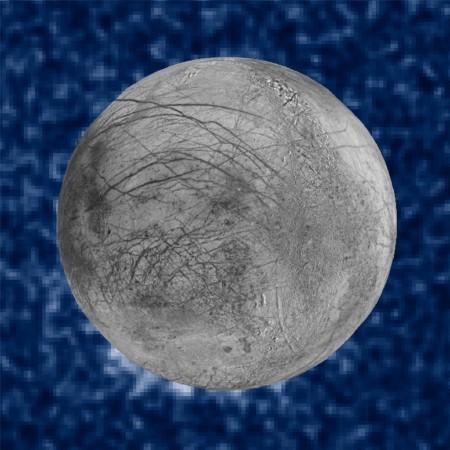
US space agency Nasa's Hubble Space Telescope recently found evidence pointing towards the presence of water under the surface of Jupiter's moon Europa. The image taken by Hubble appears to be water vapour plumes erupting from Europa's icy surface.
The scientists will not have to drill the surface or land on it for getting samples of water from the moon. The water was found on the south pole of Europa.
"Europa's ocean is considered to be one of the most promising places that could potentially harbour life in the solar system," said Geoff Yoder, acting associate administrator for Nasa's Science Mission Directorate in Washington.
"These plumes, if they do indeed exist, may provide another way to sample Europa's subsurface," Yoder added.
The amount of water on Europa is estimated to be double the amount of water found in oceans on Earth, which is covered by a hard layer of ice whose thickness is yet to be known. The researchers observed plumes of water vapour erupting from Jupiter's icy moon. These plumes are approximated to rise up to 125 miles (200 kilometres) from the surface of the moon and then fall back down.
These projections of water vapour erupting from Europa were observed by a team, which was led by William Sparks from Space Telescope Science Institute, Baltimore.
"The atmosphere of an extrasolar planet blocks some of the starlight that is behind it," Dr Sparks noted.
"If there is a thin atmosphere around Europa, it has the potential to block some of the light of Jupiter, and we could see it as a silhouette. And so we were looking for absorption features around the limb of Europa as it transited the smooth face of Jupiter," he said further.
The team of researchers observed Europa in 10 different occurrences over a span of 15 months, out of which plumes were seen thrice by the researchers.
Way back in 2012, another team, led by Lorenz Roth of the Southwest Research Institute in San Antonio, had detected the plumes of water vapour erupting from the south pole of Europa up to 100 miles (160 kilometres). Though both the teams utilised the Hubble's Space Telescope Imaging Spectrograph instrument, separate methods were used by them.
"When we calculate in a completely different way the amount of material that would be needed to create these absorption features, it's pretty similar to what Roth and his team found," Sparks stated.
"The estimates for the mass are similar; the estimates for the height of the plumes are similar. The latitude of two of the plume candidates we see corresponds to their earlier work."
Scientists will be confirming these findings regarding Europa with the help of Nasa's James Webb Space Telescope, which is infrared technology equipped and is planned to be launched in 2018. A mission to Europa is being planned by Nasa.
If the findings will be confirmed, Europa will become the second moon in the solar system with the presence of plumes after Saturn's moon Enceladus, which was discovered pluming in 2005.
"Hubble's unique capabilities enabled it to capture these plumes, once again demonstrating Hubble's ability to make observations it was never designed to make," said Paul Hertz, director of the Astrophysics Division at Nasa Headquarters in Washington, according to a press release.
"This observation opens up a world of possibilities, and we look forward to future missions - such as the James Webb Space Telescope - to follow up on this exciting discovery," he added.
"Europa's ocean is considered to be one of the most promising places that could potentially harbour life in the solar system," said Geoff Yoder, acting associate administrator for Nasa's Science Mission Directorate in Washington.
"These plumes, if they do indeed exist, may provide another way to sample Europa's subsurface," Yoder concluded.








